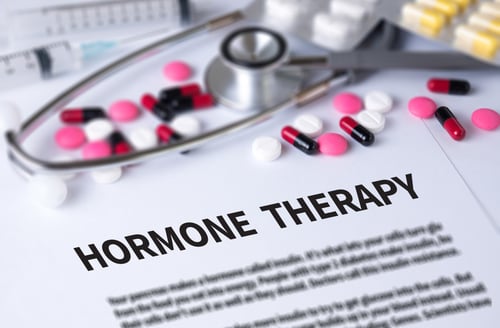Managing Early Menopause With Hormones
Managing Menopause with Hormones
You should talk with your health care provider who can help you make a decision about whether hormone replacement is right for you. This section covers the following topics:
Benefits and risks of hormone replacement therapy
The decision to take hormone replacement after menopause is a very personal decision. There are benefits and risks for hormone replacement that depend on your personal situation. Hormone replacement can improve many of the symptoms and side effects of menopause, including:
- hot flashes
- osteopenia and
- vaginal side effects
- sexual side effects
However, hormone replacement has risks, including:
- Oral has been linked to an increased risk for blood clots and stroke. skin patches do not appear to increase these risks.
- When is combined with systemic progesterone it can lead to an increased risk of breast cancer after several years of use.
- When is used without progesterone, there is an increased risk for uterine cancer.
*Note: much of the research on these risks studied older women who took hormone replacement after natural menopause.
- For healthy, high risk previvors (women who never had a cancer diagnosis) who remove their ovaries before age 45, most experts believe the benefits or hormone replacement therapy outweigh the risks, even in women with intact breasts.
- For people who have been diagnosed with breast cancer, most experts believe that the risks of hormone replacement outweigh the benefits.
Once you have made a decision to take hormone replacement, there are additional choices about the type of replacement, including:
- the type of hormones contained in the preparation
- how the hormone preparation is made
- how the hormone is delivered to the body
Type of hormones: , progesterone and testosterone
The three major sex hormones made by the ovaries are and progesterone, and the so-called “male” sex hormone, testosterone. During reproductive years, these hormones prepare the body for pregnancy, but they also affect other aspects of the body, health and well-being. After natural menopause or when the ovaries are surgically removed, these hormone levels decrease, leading to menopausal symptoms.
Most hormone replacement therapy () preparations used to treat menopausal symptoms contain either , progesterone or both hormones.
- replacement therapy () usually refers to hormone replacement therapy containing alone. tablets, skin patches, gels, sprays, lotions and a vaginal ring (Femring) are available.
- Combination estrogen-progesterone preparations are available as tablets and patches.
- Progesterone-only preparations are available as a pill, injections, vaginal gel, or an intrauterine device (IUD). Testosterone therapy is currently not approved for women in the United States.
Using alone increases the risk for uterine cancer. Adding progesterone to hormone replacement protects the uterus from cancer. For this reason, estrogen-only preparations are usually only used in postmenopausal women who have had hysterectomies. Because they have no uterus, these women have no risk of uterine cancer and therefore don’t require progesterone.
Progesterone therapy is usually added to therapy in women who still have a uterus.
Selective Receptor Modulators (SERMs)
SERMs are a type of oral medication that acts like in some parts of the body, while blocking in other parts of the body. SERMS can block the effects of in breast tissue, lowering the risk of breast cancer. Tamoxifen and raloxifene are two SERMS that are used to treat breast cancer or prevent breast cancer in high-risk women. SERMS can also treat some of the side effects of menopause. Ospemifene (Osphena) is a SERM with approval to treat vaginal dryness and pain during intercourse caused by menopause. Raloxifene can be used to prevent or treat .
Find a Menopause Expert

In the News
Study : Hormone therapy and breast cancer risk after ovary removal in women with a BRCA1 mutation
Does hormone therapy (HT) alter the risk of breast cancer for woman carrying a BRCA1 mutation who have never been...
Watch our Videos
Early Onset Menopause Management with Hormones
How the hormone preparation is made
Much attention has been focused on whether certain hormone preparations are safer or more effective than others. “Bio-identical” hormones are hormone preparations that are chemically identical to the hormones produced in the body—whether they originate in animals, plants, or are manufactured synthetics, they cannot be distinguished from the body’s own hormones. No evidence conclusively shows that bio-identical hormones are safer than other preparations.
Some physicians prescribe compounded bio-identical hormones that are prepared by pharmacists. Compounded hormone replacement is described in more detail below.
FDA-approved vs. compounded hormone preparations
Certain hormone preparations (including estradiol and progesterone), have been tested by the and are available commercially by prescription. Other "compounded" hormone preparations contain combinations of different hormones that are individually prepared by pharmacists. There is no evidence that compounded hormones are any safer than commercial hormones. Because compounded hormones are not tested or approved by the , compounded hormones may vary from one pharmacy to another. Some custom-compounded preparations are not covered by insurance plans. Occasionally, custom-compounded hormones may provide certain benefits, allowing doses and mixtures of different hormones that are not available in commercial products.
Some health care providers periodically use saliva tests to measure the overall level of hormones in patients who use compounded hormones. Many menopause experts believe this type of testing unnecessary and unreliable.
The Menopause Society, a professional organization devoted to promoting women's health and quality of life through an understanding of menopause, published a position statement on compounded hormone replacement. For most people, NAMS does not recommend custom-compounded products over well-tested, government-approved products. Nor does the Society recommend saliva testing to determine hormone levels.
How the hormone is delivered to the body: systemic, vaginal and intrauterine hormones
- Systemic hormones are given by skin patch, cream or pills. They enter the bloodstream and deliver hormones throughout the body. Systemic hormones are the most effective way to treat menopause symptoms, but they can come with side effects.
- Intrauterine Devices (IUDs) may be used to deliver progesterone directly to the uterus to protect against endometrial cancer. Intrauterine progesterone has fewer side effects than systemic progesterone.
- Vaginal hormone replacement medications such as Estring, Vagifem tablets, or Estrace or Premarin cream, Intrarosa, or Imvexxy vaginal inserts can help relieve vaginal symptoms for people who cannot take or do not need systemic hormones. These work by delivering hormones to the vaginal walls with very little absorption into the body; leading to fewer side effects and improved safety for cancer survivors and others who cannot safely take systemic hormones.
